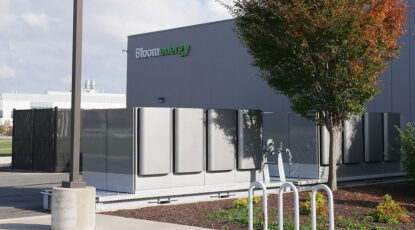In a June blog, we warned of so-called ‘once in a lifetime’ events trending towards the norm rather than the exception, as converging crises barreled toward one another. In August alone, that convergence has come to pass:
- Hurricane Isaias raced along the East Coast on August 3 and 4, leaving millions in the dark for days. Tropical Storm Marco and Hurricane Laura are now lashing the Gulf Coast
- A Derecho wind storm – essentially a wall of fast-moving thunderstorms with destructive winds – tore 770 miles through the Midwest on August 10 from South Dakota to Ohio, causing power outages for more than 1 million lasting over a week for many
- California is experiencing the longest and most extreme heat wave since 2006, causing utilities across the State to intermittently shut down power to millions
- More than 650 wildfires have burned in California since August 15 – bringing the total for the year to nearly 7,000 and threatening additional power outages during extreme heat advisories
Is this fear-mongering? No. It’s a wake-up call.

California Under Duress
A perfect storm is defined as “a particularly bad or critical state of affairs, arising from a number of negative and unpredictable factors.” California is in the midst of its own perfect storm right now. With millions of people working from home, daytime electricity usage is already running exceedingly high. Coupled with nearly 7,000 wildfires so far this year – one of the largest totals on record, the longest and most-severe heat wave since 2006, and already-planned rolling blackouts, California is simply unable to meet the energy needs of its more than 40 million residents on its own.
RELATED: California braces for a collision of crises: COVID-19 and wildfire season
For the first time in years, California is unable to import power from neighboring states because the heat wave has been so pervasive throughout the entire Western U.S. In addition, solar sources are unavailable in the evening. The California Independent System Operator issued a Stage 3 emergency alert with electricity supplies strained to a degree not seen in more than a decade.
California’s utilities were forced cut power to as many as two million residents across the state to protect the grid’s stability. The rising temperatures and wildfires caused unhealthful air quality in many areas and state officials warned people to avoid unnecessary outdoor exposure. The blackouts come amidst a backdrop of a raging pandemic and a year after more than 2 million Californians experienced preemptive power shutoffs in an effort to prevent power lines from igniting wildfires.

Stabilizing the Grid
At Bloom Energy, we focus on doing the right thing for our customers and communities, always.
Throughout the pandemic, we have consistently innovated to help those in need. In March, we launched an initiative to refurbish ventilators at our San Jose, Calif. and Newark, Del., facilities, refurbishing more than 1,200 ventilators, and in May, we rapidly deployed our Energy Servers to key locations in California to support COVID-19 patient care at temporary field hospital sites.
In the face of record-breaking temperatures and devastating wildfires, California communities continue to be effected by the state’s first rolling blackouts in more than a decade. And we’re not in the clear yet; the California Independent System Operator has advised residents to prepare for further rolling blackouts in the days and weeks ahead.
It’s during unprecedented times like these when it’s critical that communities come together and devise novel solutions to support those in need. As we started to think about how we could do our part to take action to provide relief to centralized capacity limitations in California, we knew we couldn’t do it alone.
We knew our customers in California were already reducing additional strain on the State’s aging and overtaxed grid by generating 265MW of clean and reliable power across 500 sites, using our fuel cell technology during the period of rolling blackouts; enough to prevent roughly 270,000 additional people from losing power.

We surveyed our customers with excess power to understand if they would be willing to export it to the grid, in the hopes of shoring up the grid and providing a vital solution to those in need. With the generous support and unwavering commitment from customers, partners, and civic leaders, we have been able to take megawatts of that excess power generation and return it to the grid to keep the lights on for vulnerable populations across California already grappling with the ill-effects of a pandemic. The exported supply from customers participating in this initiative – who voluntarily opted to forgo any potential sales of electricity back to the grid – were made available in most cases within 10 to 12 hours. In times of crisis, we know that every little bit helps. That is why in one case, we pulled forward the powering on of a new customer early, in the midst of the rolling blackouts, to take additional load off of the grid.
We are gratified to be able to do our part to help reduce congestion on the grid during these most unusual times and we’d be remiss not to extend our most heartfelt thanks for the generosity of our customers who answered the call to help the State, resulting in enough power back to the grid for nearly 15,000 homes.
We are hopeful that businesses and communities continue to reduce their reliance on traditional energy sources and move toward a clean and reliable source.
Keeping our Customers Powered
California regulators have cautioned that heat waves will increasingly stress the state’s electric grid. It’s one of the many reasons why microgrids are playing an increasingly important role – microgrids provide a much needed, critical, 24/7, always-on energy solution, powering critical infrastructure, offsetting demand on the grid, and supplying power to the grid when needed the most. Bloom’s AlwaysON Microgrids can be deployed in a matter of days, providing peace of mind to businesses and communities that the power they need will be there when they need it most. In the last two years alone, we’ve powered customers through over 1,500 outages and we have over 100 microgrids deployed globally. In early-August, Bloom microgrids powered customers through Hurricane Isais, preventing 25 power outages across 14 microgrids in the Northeast, including a 911 call center in Huntington, New York. Microgrids can save businesses hundreds of thousands of dollars in downtime costs and keep essential community services like grocery stores, telecoms operators, and hospitals powered through severe weather events and outages.

Conserving Where We Can
In addition to our corporate efforts, it is also important that we each take steps to conserve energy where we can. We have asked our employees, where possible and when safe to do so, to reduce their own energy consumption.
Here are a few energy-saving, no-cost tips you can take to be part of the solution:
- Wait until cooler times of the day to do tasks that make your house warmer, like laundry and cooking with the oven.
- Hang laundry outside. Take advantage of late sunsets and warm evenings to bypass your dryer and let your clothes air-dry.
- Keep AC thermostats set at 78 F degrees or higher when home when you’re home, health permitting. Every degree above 78 F represents an approximately 2% savings on cooling costs.
- Read more tips here

Through this unique partnership to supply power with help from our customers and partners, and through small actions we each take to conserve, we should be proud of our collective efforts in being a part of the solution. It’s during these times of uncertainty when our ability to provide resilient and reliable power makes all the difference to those in need. This is why we will continue striving for a future that is prepared to protect businesses and communities against climate change-related power events.
#BEprepared #TogetherWeCan #BeTheSolution
 Deepak Shukla manages the Service and Remote Monitoring Operations at Bloom Energy. Bloom’s fleet provides power at over 700 customer sites in countries around the world. Deepak has worked for Bloom Energy for over 12 years and has more than 20 years of experience in the energy industry.
Deepak Shukla manages the Service and Remote Monitoring Operations at Bloom Energy. Bloom’s fleet provides power at over 700 customer sites in countries around the world. Deepak has worked for Bloom Energy for over 12 years and has more than 20 years of experience in the energy industry.




